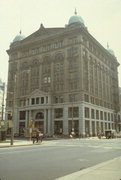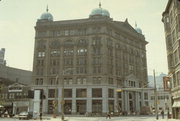| Additional Information: | A 'site file' exists for this property. It contains additional information such as correspondence, newspaper clippings, or historical information. It is a public record and may be viewed in person at the Wisconsin Historical Society, State Historic Preservation Office.
Photo re-take 4-24/29-31.
This building is also a contributing resource in the Plankinton-Wells-Water Street Historic District (listed: 6/13/86).
Charles Kieckhefer, Jr. was the builder.
Associated individuals: George Brumder, 1896, home of Germania Publishing Company.
A visual landmark in downtown Milwaukee. Constructed of brick, granite, limestone and terra cotta, the pentagonal building combines a profusion of classical stylistic details into an imposing composition. Copper-clad "Kaiser's Helmet" domes cap each corner.
Originally housed the Germania Publishing Company, George Brumder's German language publishing empire. The firm was founded in 1873 to accomodate the needs and demands of Milwaukee's large German population for books, newspapers, and magazines in their own language. Publications such as Germania, a nationally known weekly, Deutsche Volksblatt, and Hausfreund flourished under the direction of George Brumder and editor George Koeppen. The Germania Company also published several German-language Lutheran publications, including hymnals and textbooks, and Germeinde-Blatt, the official organ of the Wisconsin Lutheran Synod. Because of anti-German feeling resulting from World War I, the Germania Building was re-named for its owner. The German language press declined in the 1920s, and by the 1940s the Brumder estate had sold the building. Since then it has served as an office building. Although the exterior has undergone few changes, the interior has suffered from a series of low budget renovations and stopgap repairs. In the Milwaukee Journal of Jan. 14, 1979, Milwaukee architect Paul Gurda eloquently advocated the restoration and adaptive use of the Brumder Building. He also noted the urban design potential of the triangle which is formed by Plankington Ave., Wells and Second Streets and which is dominated by the Brumder Building.
Alderman Orville E. Pitts was a black politician during a time of racial discrimination, making him an influential member of the Milwaukee community. His law office was located here in room 816 in 1969.
"Probably no other commercial building in downtown Milwaukee exemplifies the German business presence in the city better than the Germania Building. This monumental, 8-story-tall structure was the center of immigrant George Brumder's nationwide, German-language publishing empire. Begun in 1873, the firm published books, newspapers, and magazines in the German language and also handled all of the publishing for the Wisconsin Lutheran Synod. Nineteenth century America's largest circulation German language newspaper, Germania, is probably the company's best known publication.
Brumder's business had already outgrown two previous buildings on Plankinton Avenue before planning for the present building began in 1892. Architect Eugene R. Liebert was selected to design the new structure. He had been trained in architecture in Germany and was a partner in the firm of Schnetzky and Liebert at the time. An early watercolor rendering shows that Liebert was initially inspired by what was then the world's tallest office building, the 26-story New York Wold building, which had just been built for Joseph Pulitzer in New York City. A recession in the early 1890s postponed construction of Brumder's building, and, in the interim, the structure was scaled back to its present eight stories. While incorporating such standard features of late 19th century commercial architecture as classical columns, triangular pediments with carved cupid figures, and an arcaded upper story, Liebert gave the building a definite German character as well. He replaced his originally intended classical central dome with four smaller copper clad domes placed at the corners of the roof. Their distinctive profile and bold finials resembled the German military headgear of the period and were soon nicknamed "Kaiser's helmets." The small orbs flanking each dome were once topped with majestic eagles. The most beloved German feature of the building was a 3-ton, 10-foot-high bronze statue of Germania that once stood above the main entrance. It was a copy of the allegorical figure of Germany of the German National Monument located on the Rhine River near Rudesheim, which had been erected in the late 19th century to commemorate the German victory in the Franco-Prussian War. Sadly, anti-German sentiment led to the statue's removal during World War I, and it was subsequently destroyed. Carved stone letters spelling out "Germania" were also removed from the building at that time, when it was renamed the Brumder Building.
The building was last used for publishing in 1927, when the printing operations were transferred to Winona, Minnesota. The Brumder family sold the building in 1946. It was handsomely restored int he early 1980s, at which time the name "Germania" was reinstalled on the exterior. The Germania Building is located within the Plankinton/Wells/Water Street National Register Historic District. Its facade is protected by a special easement granted to Historic Milwaukee, Inc., a local preservation group, which ensures that its repair and maintenance are done in a manner consistent with its historic character." MILWAUKEE ETHNIC COMMERCIAL AND PUBLIC BUILDINGS TOUR, CITY OF MILWAUKEE DEPARTMENT OF CITY DEVELOPMENT, 9/1994. |
|---|
| Bibliographic References: | ZIMMERMAN, 184.
MILWAUKEE ETHNIC HOUSES TOUR, CITY OF MILWAUKEE DEPARTMENT OF DEVELOPMENT, 1994.
MILWAUKEE ETHNIC COMMERCIAL AND PUBLIC BUILDINGS TOUR, CITY OF MILWAUKEE DEPARTMENT OF CITY DEVELOPMENT, 9/1994.
BUILT IN MILWAUKEE, LANDSCAPE RESEARCH, P. 86.
MILWAUKEE HISTORIC BUILDINGS TOUR: KILBOURNTOWN, CITY OF MILWAUKEE DEPARTMENT OF CITY DEVELOPMENT, 1994.
National Register Nomination Form.
Permit.
Milwaukee City Directories.
Latus, Mark and Mary Ellen Young, Downtown Milwaukee (Milwaukee Landmarks Cnsh., 1978), p. 81.
Gurda, Paul. "Brumder Building Awaits New Downtown Role," Milwaukee Journal (Jan. 14, 1979).
Soul City Times, 6/21/1969, pg. 3
Wright's Milwaukee (Milwaukee County, WI) City Directory. St. Paul: Wright Directory, 1969. Print.
Pagel, Mary Ellen & Virginia A Palmer, University Extension The University of Wisconsin, Guides to Historic Milwaukee: Kilbourntown Walking Tour, 1967. |
|---|





